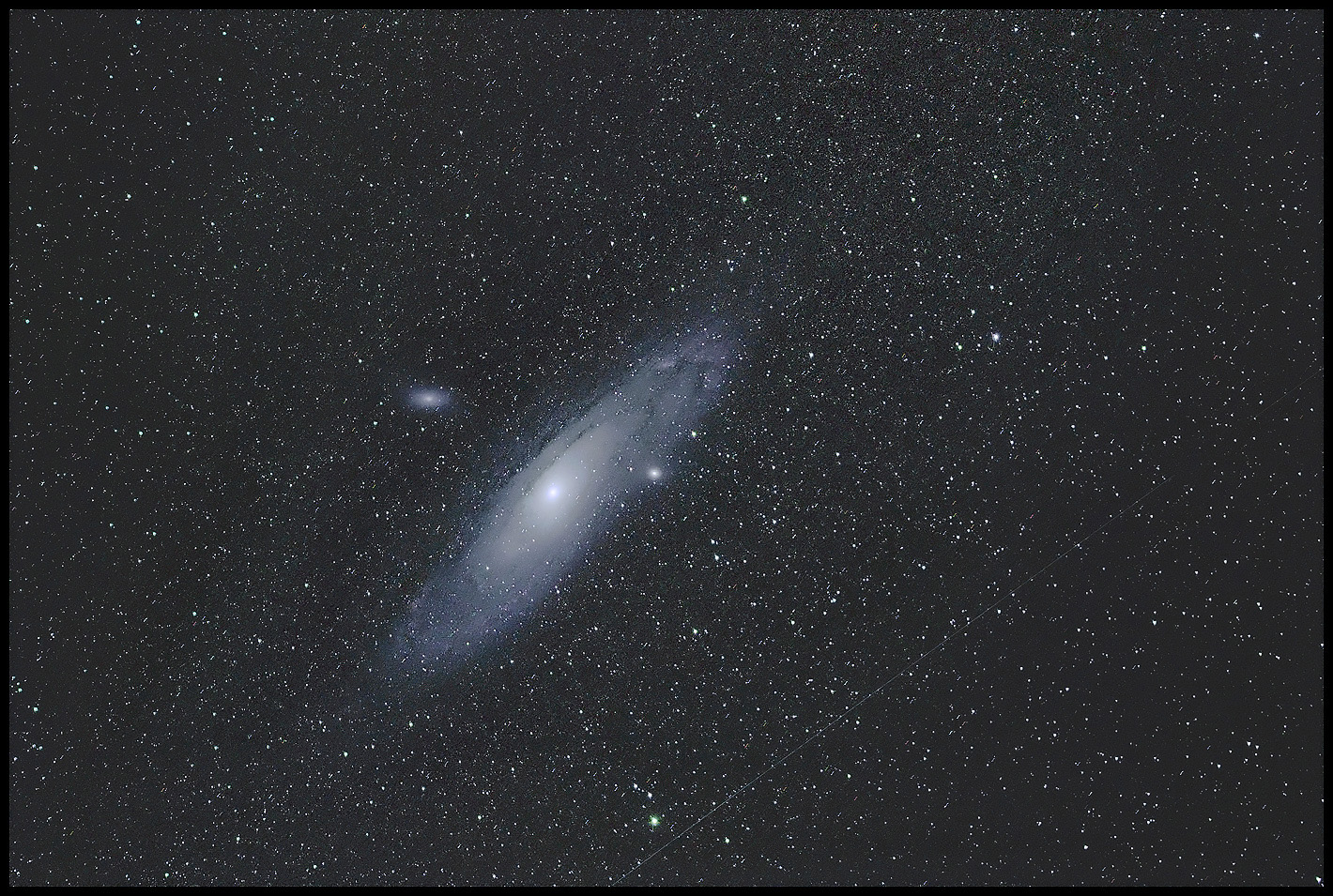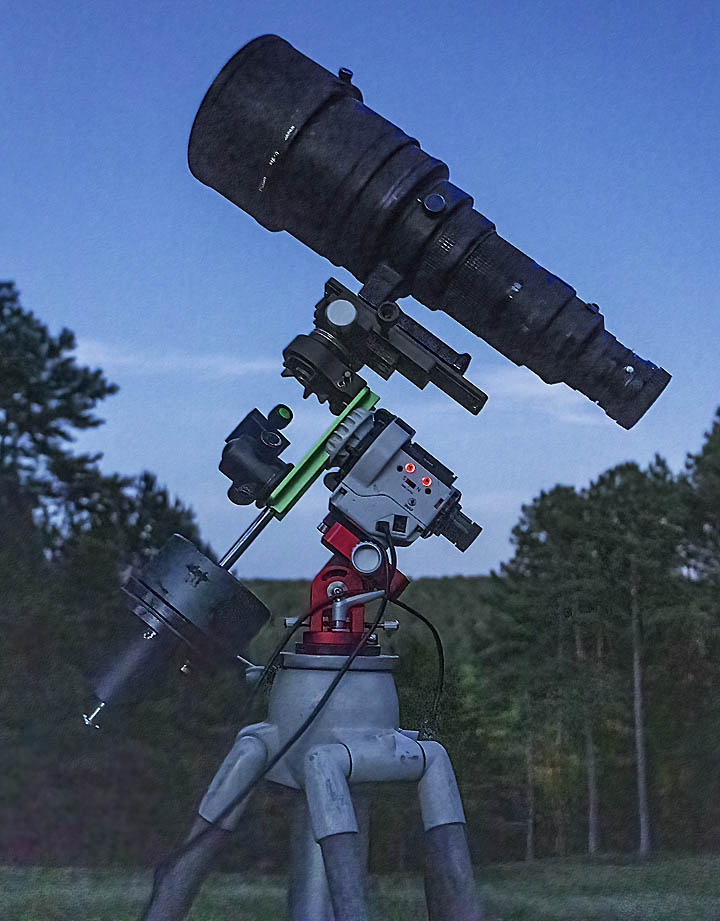The Starry Night, 262 :: home :: |
First (decent) light.
See? That system is supposed to slip back to sea off Charleston before taking pretty direct aim at right here (red edge indicators). So I got out for some fun when I could. First: the Blue Horsehead. Stay tuned. I haven't managed to produce a good finished image. My flats are inadequare for such a large, faint target. I've kept the RAWs for future use. See below! Barnard 72, Barnard's "Snake." Check my math: that photo gets to about 17th magnitude. To appear that faint, the Sun would have to be about 2,500 light-years away. Most of the stars comprising the drifts of stars in that photo are 5-10 times that far away and must be tens or hundreds of times brighter than the Sun to appear of ~15th magnitude. At a guess, on the order of a hundred thousand stars light up the original photo. Fifteen seconds is all my sky will allow. I don't need guiding for 15s exposures. With that many subs, I have to wonder what's this "noise" I hear so much about? To make tonight's flat, I set my headlamp on top of the Subaru, aimed the 400 at it, and shot through a single loose layer of postal rain bag. By backing off to ISO 200, I got the exposure up to half a second. I took a dozen flats which I averaged in Pixinsight to serve as my master. Even so casual a flat is a big improvement; a better one would be... better. Embroidery hoops are on the way, one of which is exactly the right size for the 400's outer lens hood and the rest are not. But they may work for the TMB92, the 105, etc. The set was not much more than one, so let's see. The idea is that the translucent plastic can be held in the hoop more uniformly than it can be draped; the kit will be smaller and more easily packed; tee-shirt material can be substituted, etc etc. Thus :: https://www.youtube.com/watch?v=_olH6mBf5nw After the Snake, I turned to M22. Here's M22 at left center and M28 at right plus two smaller globulars and lots of stars:
M22 contains about 80,000 stars, more or less. M28 brings us up to over 100,000. Consider that there are about as many stars packed into just those compact spherical spaces as are visible in the first photo. While the kit was busy on its own, I scouted additional locations on the community lot from which I might extend future sessions: more southern sky, visible pole star. Grabbing targets as they parade through gaps in the crowns of pines is not ideal. With the session's planned subjects in the can, I made a couple of short stacks of the Double Cluster and M31, because they were there and to set expectations, and then I called it an early-ish night:
Most of the color has leaked out of these. Worth remembering that they're just snapshots (2m15s) and merely foreshadow future efforts. File under, "Always something to learn:" I've tried calibrating the M4 and Antares images, but the flat which works reasonably well on tonight's imagery renders most of that run un-alignable -- not enough stars located. Better flats should work... better. We'll see after I put some work in on that and after the rain ends. Tonight's images brought to you by...
This is a mix of vintage and modern gear. From bottom to top: Linhof Pro tripod (1960's - 70's), Williams Optics AltAz base (current), SkyWatcher Star Adventurer tracking platform (~2021), Nikkor 400mm F2.8 ED-IF AIs (1980's) with Nikon to Canon RF adapter. There's a USB power cable attached to the SWSA, but it's being powered by 4 AA batteries. I'm pretty sure that the A-P mount is going to see some use right soon. I just need to work out an extended bar to accommodate the 400mm Nikkor near center and a place for a hefty ball head holding a second body perhaps with the 105/1.4 or with a wider lens. The ball head attachment should also accommodate a small guidescope for long exposures under darker skies or when using the ASI1600 and narrow-band filters.
8/11/2024. Clouds. Of course there have been clouds. I built a couple of embroidery hoop flatfield diffusers -- a single layer of USPO plastic for the TMB92 and a double layer for the 400mm F2.8. The former works fine for solar imaging. I suspect the latter will work under the night sky, but in deep twilight this evening I concentrated on the tilted focal plane. I tried a single layer of black electrical tape under the north side of the F>EOSR adapter. Then I moved it to the south side and then tried again without the shim. OK, smartass, explain this: when I looked at these files in CCDInspector, none of those spacers mattered a bit. This time, all of the fields were perfectly collimated and symmetrically unflat in the very same way (high center, high corners, low mid-range; total curvature around 34% -- focus a small distance off center and call it good). So, officially, just use this thing for a while and see what, if anything, needs doing. And try out the flatfield hoop for real. A casual try with it tonight (bright sky, short exposure, low ISO) was not encouraging; try it under dimmer light with more realistic exposure values.
8/16/2024. GraXpert is a freeware gradient and noise correction package which I have somehow only now discovered. To be fast, the denoise feature needs to use GPU acceleration which I can't allocate under Windows 10. This machine will not run Windows 11. This is the first sign of age I've seen after 8 years(!). The lesson of its long life, I think, is to go ahead and shop close to the bleeding edge; don't try to save money by buying too far behind the curve. Here's the Blue Horsehead extracted from 130, fifteen second exposures made a couple of weeks ago (look way up at the top in this page). I lost the color somewhere along the way and will revisit that by and by. The full-res image took about an hour to process; what you see here is based on a 2k downsampled version of PI's linear stack. (Note to self: always keep the raw linear stack out of PixInsight.) Background extraction and denoise required about 12 minutes. (DeNoise requires the great majority of that time -- don't bother with noise suppression, and it's practical to work with full-sized images). Not bad, I say. Sure, make these big. Why not?
GraXpert is found in PixInsight via Script/Toolbox/GraXpert More about all this to come. First there's some hardware to mess with ahead of an inbound comet.
:: top :: |
© 2024, David Cortner







